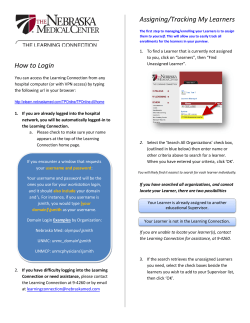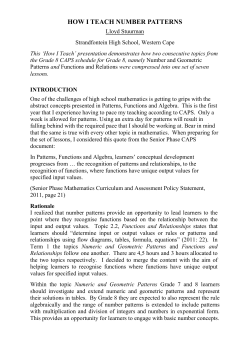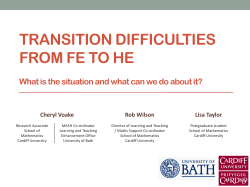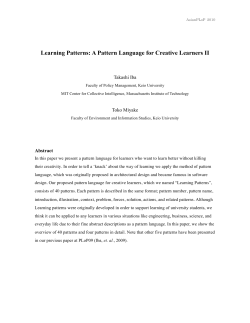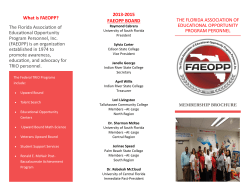
WHY TEsol? THEoriEs ANd issuEs iN TEACHiNg ENglisH To spEAkErs of
Why TESOL? Theories and Issues in Teaching English to Speakers of Other languages in K–12 Classrooms Fourth Edition Eileen N. Whelan Ariza Carmen A. Morales-Jones Noorchaya Yahya Hanizah Zainuddin Florida Atlantic University Boca Raton, Florida Book Team Chairman and Chief Executive Officer Mark C. Falb President and Chief Operating Officer Chad M. Chandlee Vice President, Higher Education David L. Tart Director of Publishing Partnerships Paul B. Carty Editorial Manager Georgia Botsford Editor Denise M. LaBudda Vice President, Operations Timothy J. Beitzel Assistant Vice President, Production Services Christine E. O’Brien Senior Production Editor Mary Melloy Senior Permissions Coordinator Renae Horstman Senior Cover Designer Janell Cannavo Cover image © Shutterstock, Inc. www.kendallhunt.com Send all inquiries to: 4050 Westmark Drive Dubuque, IA 52004-1840 Copyright © 2000, 2002, 2006, 2010 by Kendall Hunt Publishing Company ISBN 978-0-7575-7627-0 All rights reserved. No part of this publication may be reproduced, stored in a retrieval system, or transmitted, in any form or by any means, electronic, mechanical, photocopying, recording, or otherwise, without the prior written permission of the copyright owner. Printed in the United States of America 10 9 8 7 6 5 4 3 2 1 Dedication We wish to dedicate this book to all the children who, for many reasons, migrate to the United States and become English language learners in our schools. It is our strong belief that they deserve the most qualified teachers possible. This book is our contribution to the education of teachers who will make a positive difference in the lives of these children, who in turn will significantly influence the future of this great nation. The Authors "Why TESOL?" 4th ed. by Ariza et al (www.kendallhunt.com/ariza) © 2010 Kendall Hunt Publishing Co. Contents Foreword vii Preface ix Acknowledgments xii About the Authors xiv Part One: A Knowledge Base for English Language Teaching 1 1 2 Why TESOL? Diversity in America (Carmen A. Morales-Jones) 3 Legal Rights of English Language Learners (ELLs) in the United States: A Historical Overview (Carmen A. Morales-Jones) 11 3 Description of ESL/ENL Programs from A to Z (Carmen A. Morales-Jones) 21 4 The English Language Learner (Carmen A. Morales-Jones) 31 Part Two: A Knowledge Base for Linguistic Systems 37 5 Human Language (Noorchaya Yahya) 39 6 Phonology (Noorchaya Yahya) 45 7 Morphology (Noorchaya Yahya) 57 8 Syntax (Noorchaya Yahya) 65 9 Semantics (Hanizah Zainuddin) 71 10 Pragmatics (Hanizah Zainuddin) 81 11 Non-Verbal Communication (Hanizah Zainuddin) 91 12 Discourse (Hanizah Zainuddin) 95 13 Dialectal Variations (Noorchaya Yahya and Hanizah Zainuddin) 103 14 Development of the English Language (Noorchaya Yahya and Hanizah Zainuddin) 113 Part Three: A Knowledge Base for Language Theories and Applications 123 15 First and Second Language Acquisition (Hanizah Zainuddin and Noorchaya Yahya) 125 16 Non-Linguistic Factors That Influence Second Language Acquisition (Hanizah Zainuddin) 17 First and Second Language Acquisition Theories and Models (Hanizah Zainuddin 139 and Noorchaya Yahya) 145 18 Meeting the Needs of English Language Learners (Carmen A. Morales-Jones) 163 19 Strategies and Styles (Hanizah Zainuddin and Noorchaya Yahya) 169 20 Language Learning Errors and Strategies for Error Correction (Hanizah Zainuddin) 21 Language Methodologies (Noorchaya Yahya) 189 "Why TESOL?" 4th ed. by Ariza et al (www.kendallhunt.com/ariza) © 2010 Kendall Hunt Publishing Co. 183 Part Four: A Knowledge Base in Assessment and Evaluation 197 22 Assessment and Evaluation for the English Language Learner (ELL) (Eileen N. Whelan Ariza) 23 Responding to a Court-Imposed Consent Decree: A Look at Initial Placement and Assessment 199 (Eileen N. Whelan Ariza) 209 24 How Does a Classroom Teacher Assess and Evaluate an English Language Learner? (Eileen N. Whelan Ariza) 215 25 English Language Learners and Standardized Tests (Eileen N. Whelan Ariza) 221 26 Why Alternative Assessment for English Language Learners? (Eileen N. Whelan Ariza) 227 Part Five: Teacher Reflections: Notes from the Field 237 Teacher Reflections: Notes from the Field 238 Appendices 243 Glossary of Professional Terms 303 References 307 Index 315 vi Contents "Why TESOL?" 4th ed. by Ariza et al (www.kendallhunt.com/ariza) © 2010 Kendall Hunt Publishing Co. Foreword As cultural and linguistic diversity has increased in classrooms across North America and in other parts of the world, it has become clear that the knowledge base required to effectively teach in these classrooms must include specialized information about second language development and its relationship to academic success. It is a pleasure to write a foreword for a book that articulates this expanding knowledge base in a clear, accessible, and comprehensive manner. This book is particularly timely in view of the increased concern about accountability in our schools. The requirement in states such as Florida, that all teachers of English language learners obtain appropriate qualifications to prepare them to teach these students effectively, reflects this concern for accountability. We still, however, face many challenges in implementing appropriate educational reforms that create effective and equitable learning environments for culturally and linguistically diverse students. Among these challenges are the following: ñ Ensuring that statewide assessment mandates are valid and realistic for English learners, in addition to students for whom English is their first language (L1); ñ Providing appropriate instructional support for English learners, not only in the early stages of learning conversational English, but also in the longer process of catching up in academic aspects of English; ñ Building flexibility into instruction and assessment provisions that recognizes the diversity among English learners and avoids slotting these students into a “one-size-fits-all” school system intended for “generic” monolingual, monocultural, English L1 students; ñ Ensuring that special education assessment procedures are valid for English learners so that these students are not over-represented in categories such as “learning disability” or “communicative disorder” as has happened in the past; ñ Providing encouragement and opportunities for students to continue to develop their home language ability, as this is the foundation upon which we construct English academic development. Because issues related to immigration and increasing diversity have been controversial, it is not surprising that there are many misconceptions regarding the language and academic development of bilingual students. For example, students are often assumed to have overcome the “language barrier” when they have acquired the ability to converse relatively fluently in English. We know, in fact, that it can take much longer (five or more years) for students to bridge the gap in academic aspects of English. Similarly, students’ first languages are still frequently seen as either irrelevant or detrimental to their academic progress. Nothing could be further from the truth. For more than thirty years, research has shown that bilingual students who continue to develop their L1 as they acquire English experience linguistic advantages such as increased awareness of how language works and how to use language effectively. As one example, students from Spanish-speaking backgrounds have a significant potential advantage in gaining access to the low-frequency Latin- and Greek-based lexicon of academic English, since most of these words have cognates in Spanish. The word encuentro in Spanish is a cognate of the English word encounter, which is much less frequently used than its Anglo-Saxon derived synonym meet. As students progress through the grades and learn ever more complex concepts in science, math, and social studies, the proportion of low-frequency Latin- and Greek-derived vocabulary that they must learn increases dramatically. Spanish-speaking students’ "Why TESOL?" 4th ed. by Ariza et al (www.kendallhunt.com/ariza) © 2010 Kendall Hunt Publishing Co. vii L1 can be a significant advantage in this process. If we are aware of these extensive L1/L2 linkages, we can help students to search for cognate connections in texts, thereby increasing their ability to infer the meanings of unknown words. This volume is clearly not intended as a recipe book for implementing appropriate instruction for English-language learners. There are no recipes or formulas that can be applied to every student or situation. Rather, the intent is to provide educators with the information necessary to make informed and skillful decisions regarding the school policies and instructional practices that are likely to be effective in addressing the learning needs of a very diverse group of students. This implies that we must see ourselves individually and collectively as researchers who are learning from our own experiences in teaching bilingual students. Our goal should be not only to implement a knowledge base, but also to contribute to it. In order to apply the existing knowledge base to our own unique context, and to contribute to the expansion and refinement of this knowledge base, we must engage in a collective problem-posing and problemsolving process. What approaches have worked for us in the past? What strategies are in place in our schools for involving parents and the community? Are there ideas that have been implemented elsewhere that might improve our practice in this and other areas? Do we, as a school faculty, have a consistent set of beliefs and assumptions about language and literacy teaching for bilingual students? If not, how can we discuss and resolve inconsistencies so that students are not confused by very different instructional strategies from one year or classroom to the next? What accommodations and/or instructional strategies might be helpful to enable English learners to succeed on state-mandated assessments, despite the fact that they may be required to undergo these assessments long before they have had time to catch up academically in English? There are no easy answers to many of these questions, but we are much more likely to pursue reasonable directions if we are discussing the issues within our own faculty, drawing on our collective experience, and brainstorming possible solutions. In other words, every school can benefit from articulating a language policy—a set of beliefs and practices about language learning and academic achievement that have been formulated specifically with the students we teach in mind. Such a policy should be sensitive, both to the unique situation of our students (and faculty) and the general knowledge base that exists from research and theory. The present volume provides an excellent starting point to understanding the knowledge base that already exists. As educators, we should see ourselves as adding to this knowledge base as a result of our individual and collective actions to implement the best possible instruction for all our students. In conclusion, it is common these days to hear policymakers and school administrators talk of the school as a learning institution. In doing so they usually try to imply not only that schools are institutions where pupils are engaged in learning, but also that the school itself must continue to learn from its own collective experiences if it is to adapt to the changing cultural, economic, technological, and global challenges of the twenty-first century. As educators, we are in the vanguard of this learning process when we welcome new students and families into our society. We have to learn from our own experiences—our successes and failures—if we are to implement effective instruction and contribute significantly to the knowledge base regarding the education of linguistically and culturally diverse students. Jim Cummins The University of Toronto viii Foreword "Why TESOL?" 4th ed. by Ariza et al (www.kendallhunt.com/ariza) © 2010 Kendall Hunt Publishing Co. Preface Audience and Purpose We have written Why TESOL? Theories and Issues in Teaching English to Speakers of Other Languages in K–12 Classrooms to provide current and prospective teachers who have English language learners in their classrooms with a knowledge base in the field of teaching English as a second/new language (TESOL). Today, more than ever, when teachers enter their classrooms they encounter a diversity in the student body that brings richness, and at the same time challenges, that teachers must address. The intent of this book is to provide an in-depth theoretical background for teachers as they try to address the needs of English language learners in their classrooms. In Why TESOL? Theories and Issues we provide: ñ National statistics that help clarify the global nature of our American society in this twenty-first century ñ A historical perspective on the laws that have influenced the teaching of English language learners in ñ ñ ñ ñ ñ today’s schools A description of a variety of English as a second/new language (ESL/ENL) programs A profile of English language learners and the needs they bring to today’s classrooms An analysis and explanation of the nature of language and first or native language acquisition A discussion of second language theories and models A look at assessment and relevant issues as they relate to English language learners Organization Why TESOL?, fourth edition, has five parts. Part One develops an essential knowledge base for readers. It describes the legal rights of English language learners (ELLs) and gives an historical overview of the laws that have had an impact on what is being done today to address the needs of ELLs in America. Part One also provides a clear classification of English as a second/new language (ESL/ENL) programs available throughout the United States, as well as a discussion of factors that affect the design of these programs. Lastly, Part One offers a profile of English language learners in the United States. Part Two provides a basic grounding in the core areas of linguistics: phonology, morphology, syntax, pragmatics, discourse, and other related areas, such as non-verbal communication, dialectal variation, English language development, and World Englishes. This section is not intended to be an exhaustive study on the language system; rather it attempts to get the reader’s “feet wet” when it comes to the nature of the English language. Such an understanding of how language works and what it means to know a language will help the reader understand the complexities involved in acquiring a language. This section begins with a general introduction of the universals across languages. Despite the linguistic divergence of the world’s languages, human languages are remarkably similar in many ways. All languages share the same common properties and components, such as phonology, morphology, syntax, and semantics which make up the grammar of a language and make human communication possible. Part Two then provides a description of the sound systems of a language, including all the possible sound sequences and constraints, and discusses why certain sounds "Why TESOL?" 4th ed. by Ariza et al (www.kendallhunt.com/ariza) © 2010 Kendall Hunt Publishing Co. ix are difficult for foreign speakers to produce. Next, it introduces concepts related to the process of word creation within a language and how we learn to recognize words or non-words in a language. It also examines how we recognize and form grammatical sentences and interpret potential ambiguities within a sentence and highlights potential difficulties that second language learners may have with English sentences. A chapter is also devoted to a discussion of how speakers arrive at meanings of words and sentences in their native language and how this process is filtered through the experience, culture, and worldview of the speakers. The second half of this section looks at a number of related issues. It examines how speakers use language to carry out specific linguistic and social tasks and how the context of a language event influences meaning. It also describes differences in non-verbal communication across cultures and how these differences may result in misunderstandings between native and non-native speakers. Cross-cultural conversational and rhetorical patterns are also discussed with implications for teachers to facilitate second language learners’ communicative abilities in their target language. Part Two then discusses how variation in human languages is influenced by factors related to socioeconomic status, region, and ethnicity and takes a brief look at the sociolinguistic and linguistic profiles of the different varieties of English used around the world. Finally, the section ends with a brief overview of the historical development of the English language, how language families are established based on lexical similarities between languages, and the influence of other languages on English as demonstrated by extensive loan words in English. Part Three contains first and second language theories and applications. Issues discussed focus on first and second/new language processes with the developmental milestones in first and second language learning compared from a linguistic perspective. The non-linguistic factors affecting second language acquisition, such as age, personality, cognitive factors, sociocultural factors, motivation, and learning environment, are also discussed. Another section explains the complexity of the second language acquisition process through first language acquisition theories such as the behaviorist, innatist, cognitivist, social interactionist, and brain-based approaches. It also discusses second language acquisition theories and models such as Krashen’s Monitor Model, Cummins’ Second Language Framework, Selinker’s Interlanguage Theory, McLaughlin’s Attention-Processing Model, and Bialystok’s Analysis/Automatic Processing Model. Examples of common linguistic problems faced by English learners of different language backgrounds have been added in chapter 17 to help teachers recognize that English learners' errors may be attributed to first language interference and/or difficulties with learning complex, less predictable, and highly irregular structures in English. Strategies and styles in language learning such as Gardner’s Multiple Intelligence Model, Cognitive Academic Language Learning Approach (CALLA), and second language communication strategies are also explored. Sources of error and error treatment are discussed to help teachers understand the difficulty learners experience when learning a new language. The development of methodologies in foreign language teaching and ESL teaching is traced, starting with the more traditional methods, such as the Grammar Translation Method, to the later approaches, such as the Natural Approach and the Whole Language Approach. The section ends with a chapter that argues the significance of meeting the needs of English language learners. Part Four of this book addresses the importance of teachers being accountable for effective teaching. This is especially important when we assess students who are learning English, and we are expected to grade them regardless of their proficiency levels. How do teachers make sure that they are testing academic content as opposed to language proficiency? This topic is thoroughly explored, as it is important to understanding the appropriateness of standardized tests versus alternative assessments when determining the success of instruction and learning for English language learners. Finally, the laws governing testing and assessment are examined so teachers can see how legal issues affect their daily planning, grading, and implementing proper administrative procedures in accordance with fairness and the law. Part Five is a short section in which a new teacher and an experienced teacher share their classroom experiences. They tell how they adapt themselves and their teaching strategies to better measure the academic successes of the second language learners in their mainstream classrooms. Preface "Why TESOL?" 4th ed. by Ariza et al (www.kendallhunt.com/ariza) © 2010 Kendall Hunt Publishing Co. Features Why TESOL? contains the following pedagogical features designed to make the material accessible and lasting for the reader: ñ Because it is believed that readers should have an idea of what the chapters will be addressing, each chapter presents the “Key Issues” discussed in the chapter. ñ Each chapter opens with a “real life” scenario intended to capture the essence of the chapter. The reader can later go back to this scenario and consider the content of the chapter and how it was reflected in the opening scenario. ñ In our effort to help the reader acquire the most essential knowledge base, each chapter ends with a list of key “Points to Remember.” To help the reader reflect on and apply the knowledge acquired from each chapter, a separate CD workbook has been developed. For each chapter, there are a series of “Challenge Sheets” containing exercises/ questions/research assignments to be completed after reading the chapter. Instructors using this book as a text for an ESOL class may require students to complete these sheets to be turned in as part of their written assignments. Glossary of Terms At the back of Why TESOL?, an in-depth definition of key acronyms employed throughout the book has been included. In addition, key terms have been listed and defined for quick reference. Some Points for Clarification Typically, English learners speak a primary language other than English at home. English learners vary in their proficiency in their primary languages, as well as in English. Beginners to intermediates in English are often referred to as limited English proficient (LEP), a term that is used in federal legislation and other official documents (Peregoy & Boyle, 2005). In this book the terms English language learners, English learners, second language learners, non-native speakers of English, language minority students, and language enriched pupils will be used synonymously to refer to students who are in the process of acquiring English as a new language and whose primary language is not English. (Refer to Glossary of Terms for further clarification.) "Why TESOL?" 4th ed. by Ariza et al (www.kendallhunt.com/ariza) © 2010 Kendall Hunt Publishing Co. Preface xi Acknowledgments At this point we would like to talk about Jim Cummins. Dr. Cummins’ research on BICS (Basic Interpersonal Communication Skills), or social language, and CALP (Cognitive Academic Language Proficiency), or academic language, provided an academic epiphany in the field of TESOL. When we first read his research, it made us exhale with relieved understanding as we had finally found a name to apply to the phenomenon occurring in our schools that showed English language learners speaking perfect English while failing academically. This research is valuable information we can relay to our pre-service and practicing teachers as it arms them with a knowledgeable answer when confused educators ask, “Why is this child in ESL/ENL? He speaks perfect English!”, as the child fails dismally. With this knowledge in their cache, teachers are able to apply powerful strategies for potent classroom instruction. We wish to thank Dr. Cummins for taking the time to read this manuscript, and for writing the foreword. It gives us great personal pleasure and professional satisfaction to know an individual of his stature endorses the work we are doing, as we prepare teachers to graduate with TESOL competency ready to teach linguistically, ethnically, and culturally diverse students in the classrooms of today, and of the future. Eileen N. Whelan Ariza, Ed.D. Carmen A. Morales-Jones, Ph.D. Noorchaya Yahya, Ph.D. Hanizah Zainuddin, Ph.D. Florida Atlantic University Boca Raton, Florida Writing a book can be a delightful torture that lasts for years, as life goes on around you. Deadlines loom as your family and friends wait patiently for you to finish that one last word or thought, before it escapes you forever. Papers, articles, books, and references are strewn about the house and office with wild abandon. Neatness, such as it was, becomes an elusive goal. But although I write alone, I cannot do it alone. I write for pleasure, as my incredible children, Stefani and Nico, take a temporary back seat, but they always show their pride in my work. I am deeply grateful to them and they are the loves of my life. I dedicated this book to them. I also could not have completed this project without the help of Renee Zelden, a whiz at administrative details and organization. She has an incredible eye, noticed things I overlooked, and helped me make my work a success. Thank you, Renee; you and your lovely mom, Janice Zelden, have proved to be unforgettable additions to my universe. My mother, Nancy Whelan, I thank as well, because she always told me I could be anything I wanted to be. She was the one who told me: “go travel, see the world . . .” and “Bring any of your friends home . . . I don’t care where they are from, or what color, or faith they are . . .” and “Why don’t you learn Spanish,” which led me to my life and career today. Awesome woman that she is, she made the first cross-cultural leap in the family by having the audacity to be an Anglo Protestant who married an Irish Catholic bar owner in the 1940’s—a radical move! Eileen N. Whelan Ariza Associate Professor of TESOL Florida Atlantic University Boca Raton, Florida, Spring 2006 xii "Why TESOL?" 4th ed. by Ariza et al (www.kendallhunt.com/ariza) © 2010 Kendall Hunt Publishing Co. I wish to thank my loving husband, Charlie, for his continued support and endless encouragement. He, who so willingly and unselfishly has shared me with my writing throughout the entire revision process of this book, deserves my heartfelt thanks. “How blessed I am to have such a caring and loving and supportive presence in my life.” Carmen A. Morales-Jones, Professor Florida Atlantic University Boca Raton, Florida, Spring 2006 I would like to thank my three sons, Shafiq, Abdullah, and Abdul, for being so understanding and patient. My gratitude goes to Suzzane St. Aubin and others who helped me through the writing of this manuscript. Noorchaya Yahya, Associate Professor Florida Atlantic University Port St. Lucie, Florida, Spring 2006 I am deeply indebted to my husband and two children who have been so patient with me and especially forgiving for the many hours and weekends that I have spent finishing this manuscript. Hani Zainuddin, Associate Professor Florida Atlantic University Boca Raton, Florida, Spring 2006 The authors would like to thank Marci Maher and Betty Lacayo, a veteran teacher of ESOL students, who is an expert on literacy-based curriculum in St. Lucie County, for sharing her insights with us, and thanks also go to Bianca Swanson for sharing her rubric (which was a class assignment). Finally, to all the educators trying to become ESOL endorsed, thank you for making the effort to learn how to successfully teach the delightfully diverse English language learners. The Authors "Why TESOL?" 4th ed. by Ariza et al (www.kendallhunt.com/ariza) © 2010 Kendall Hunt Publishing Co. Acknowledgments xiii About the Authors Eileen N. Whelan Ariza received her Ed.D. in Multilingual/Multicultural Education from the University of Massachusetts, Amherst, and her MAT in TESOL, Spanish as a Second Language, and her Bilingual/Multicultural Endorsement from the School of International Training in Brattleboro, Vermont. A Teaching Fellow for many years at Harvard University’s English Language Institute, she is now an associate professor of TESOL in Florida Atlantic University’s teacher education program, where she prepares both prospective and current teachers in the undergraduate and graduate programs for Florida’s mandated ESOL endorsement. Ariza has spent time in more than 70 countries, and has taught English as a foreign and second language in eight countries to students ranging from preschoolers to the elderly. Her primary research interests are in ESOL, both in the United States and overseas, cross-cultural communication, and preparation of mainstream teachers with English learners in their classroom. Carmen A. Morales-Jones received her Ph.D. in Curriculum and Integrative Studies from Florida State University, Tallahassee, in 1975. Her career encompasses the teaching of ESL and French at the Laboratory School of the University of Puerto Rico, as well as a teacher educator at Florida Atlantic University in the area of language acquisition (language arts for elementary education majors, foreign languages for foreign language majors, and English as a new language for elementary pre-service teachers and in-service teachers). Currently, she is on phased retirement after having served as a professor of education at Florida Atlantic University for thirty years. She teaches and supervises student teachers and interns in the spring semesters. Her research interests are in the areas of teacher training, English language acquisition, and foreign language teaching. xiv "Why TESOL?" 4th ed. by Ariza et al (www.kendallhunt.com/ariza) © 2010 Kendall Hunt Publishing Co. Noorchaya Yahya received her Ph.D. in rhetoric and linguistics from Indiana University of Pennsylvania. Currently, she is an associate professor at Florida Atlantic University, where she teaches TESOL methods courses. She has taught ESL for more than ten years at institutions of higher learning both inside and outside of the United States. She is currently involved in the training of pre-service teachers for ESOL endorsement and in-service teachers for ESOL certification in Florida. Her research interests lie in the areas of second language writing, teacher education, and second language acquisition. Hanizah Zainuddin received her Ph.D. from Indiana University, Bloomington, Indiana, in 1995 and is currently an associate professor of TESOL at Florida Atlantic University, Boca Raton. Her areas of interest include second language writing, contrastive rhetoric, teacher education, family literacy, the potentials offered by learner stories in bridging intergenerational relationships between immigrant adults and their “Americanized” children, and the sociocultural adaptations of indigenous and immigrant populations in the United States. She also has extensive experience teaching English as a second language to adults and adolescents inside and outside of the United States. She is currently involved in a project to develop a curriculum that reflects the issues and needs for English language use of Mayan adults from Guatemala who are currently residing in the United States. "Why TESOL?" 4th ed. by Ariza et al (www.kendallhunt.com/ariza) © 2010 Kendall Hunt Publishing Co. About the Authors xv
© Copyright 2025


